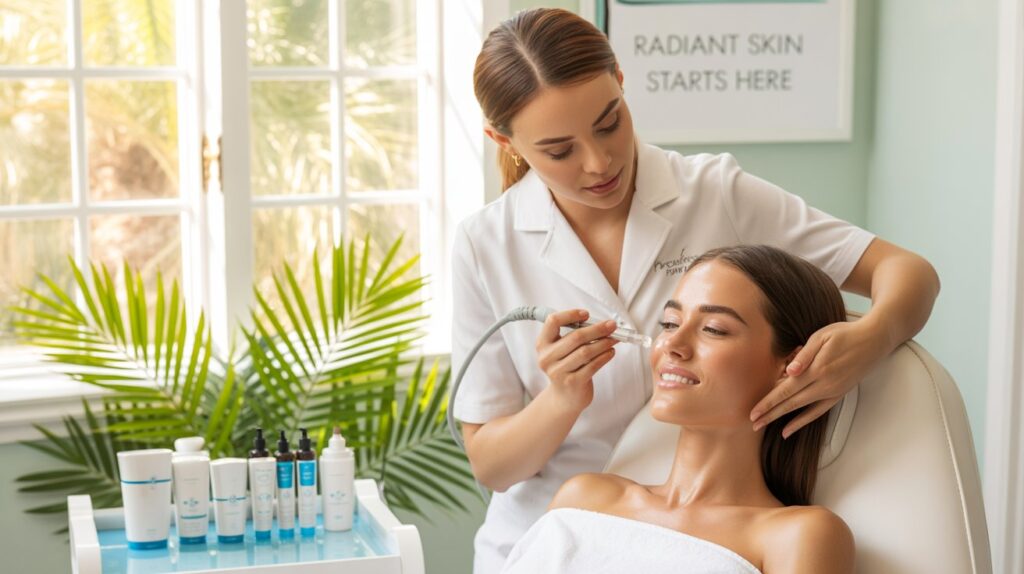Chemical Peels vs. Hydrafacial: What Works Best in Florida’s Climate?

Florida’s sunny weather and humid climate can be both a blessing and a challenge for your skin. Constant sun exposure, high humidity, and salty air can lead to clogged pores, uneven skin tone, and premature aging. That’s why professional med spa treatments like chemical peels and Hydrafacials are so popular across Florida.
But which one is better suited for Florida’s climate? Let’s dive into the differences between chemical peels and Hydrafacials, their benefits, and which treatment may be right for your skin.
Overview: Chemical Peels vs. Hydrafacial
- Chemical Peels: Use a blend of acids (like glycolic, lactic, or salicylic) to exfoliate the skin and remove dead layers.
- Hydrafacial: A non-invasive, multi-step facial treatment that combines cleansing, exfoliation, extraction, hydration, and antioxidant protection.
Both treatments aim for smoother, brighter skin but work in different ways.
1. What Is a Chemical Peel?
A chemical peel involves applying a safe chemical solution to the skin, which exfoliates and eventually peels off, revealing fresh, new skin beneath.
Benefits of Chemical Peels:
- Treats sun damage and hyperpigmentation.
- Reduces acne scars and fine lines.
- Improves skin texture and tone.
Best for Florida’s climate: Chemical peels are great for repairing sun damage caused by the state’s strong UV rays, but they require sun protection post-treatment to avoid irritation.
2. What Is a Hydrafacial?
A Hydrafacial is a gentle, medical-grade treatment that deeply cleanses, exfoliates, and hydrates the skin using a patented vortex technology.
Benefits of Hydrafacials:
- Hydrates and plumps dry skin.
- Removes impurities and unclogs pores (ideal for humid climates).
- No downtime or peeling.
Best for Florida’s climate: Perfect for maintaining hydration and combating humidity-related breakouts while being safe for all skin types.
3. Key Differences
| Feature | Chemical Peel | Hydrafacial |
|---|---|---|
| Exfoliation Level | Medium to deep | Gentle, surface-level |
| Downtime | 3–7 days (peeling phase) | None |
| Best For | Sun damage, pigmentation | Hydration, glow |
| Ideal Frequency | Every 4–6 weeks | Monthly |
4. Which Works Best in Florida?
- If you have sun damage, age spots, or deeper skin concerns, a chemical peel may offer better results.
- If you want hydration, radiance, and instant results with zero downtime, Hydrafacial is perfect—especially for Florida’s hot and humid weather.
Pro tip: Many med spas in Florida recommend alternating between both treatments for optimal skin health.
FAQs: Chemical Peels vs. Hydrafacial in Florida
1. Can I do chemical peels year-round in Florida?
Yes, but extra sun protection (SPF 50+) is essential due to strong UV exposure.
2. How often should I get a Hydrafacial?
Every 4–6 weeks for best results, especially if you spend time outdoors.
3. Is Hydrafacial good for sensitive skin?
Yes, it’s a gentle, customizable treatment suitable for all skin types.
4. Can I combine Hydrafacial and chemical peels?
Yes, many med spas offer combination packages for deeper exfoliation and hydration.
Final Thoughts
Both chemical peels and Hydrafacials work wonders for skin health, but your choice depends on your skin goals and Florida’s climate challenges. For regular maintenance and hydration, Hydrafacials are ideal. For targeted treatment of sun damage or aging signs, chemical peels offer dramatic improvements.
